|
Category
|
Mausoleum of Pahlavan Mahmud
The original building of the mausoleum was a modest and small, but because it has become a popular place of pilgrimage, soon were built “hujra”, “khanaka” and the mosque where the pilgrims also made prayer. In the XVIII century on the south side of the building was built in the entrance portal of the mausoleum. In 1719 Shergazi Khan, building new madrasa, oriented it to the mausoleum of Pahlavan Mahmud.
In 1913, commissioned by Isfandiyar Khan on the western side of the courtyard was built two-story building, and on the east side - year-old mosque.
Construction works were carried out under the guidance of famous Khiva architect Muhammad Murad. There are the names of master potters who participated in the design of the mausoleum - a usto Sufi Mohammad Niaz and usto Abdullah Jinn, which determined the style of decorating the buildings of Khiva for decades to come. Gradually, the mausoleum became a majestic building with the largest dome in Khiva, covered with blue glazed tiles with sparkling gold-plated tip. Pahlavans (strongmens, heroes) will always revered by the people, and each athlete had his own legend. Local oral tradition gives a description of many details connected with the life and exploits of Pahlavan Mahmud, who was a famous poet, furrier by profession and a philosopher in the Spirit, and also had the ability to heal people. During his life he gained recognition and fame far beyond the Khiva Khanate.
Pahlavan Mahmud traveled a lot, and furriery craft enabled him to earn a living. Strongman from Khiva, famed for his heroic strength undefeated fighter, always defeated his opponents in Afghanistan, India, Iran and Iraq. Only once he lost the fight, when he learned that his opponent in the case of failure, could face the death penalty. At present, many of these countries remain relics connected with the name of Mahmud. And in Iran, professional wrestlers, before entering into a duel with his rival, turn in prayer to the patron saint of wrestlers - St. Pahlavan Mahmud.
According to legend, the poet was buried in a studio near his home. After his death he began to read like a “peer” (the saint patron) of Khiva and his modest tomb became a place of worship for believers. |
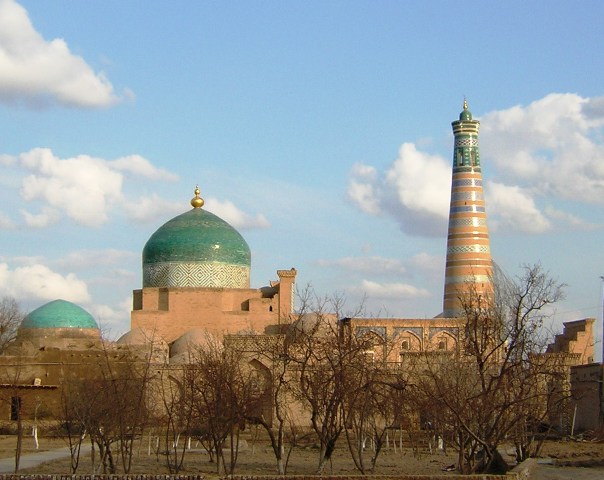 One of the best works of Khivian architecture - mausoleum of Pahlavan Mahmud - done in the tradition of Khorezm architecture of XVIII-XIX centuries. It was built in honor of the famous Khiva poet, craftsman and undefeated fighter, famous for his herculean strength, Pahlavan Mahmud (1247-1326).
One of the best works of Khivian architecture - mausoleum of Pahlavan Mahmud - done in the tradition of Khorezm architecture of XVIII-XIX centuries. It was built in honor of the famous Khiva poet, craftsman and undefeated fighter, famous for his herculean strength, Pahlavan Mahmud (1247-1326).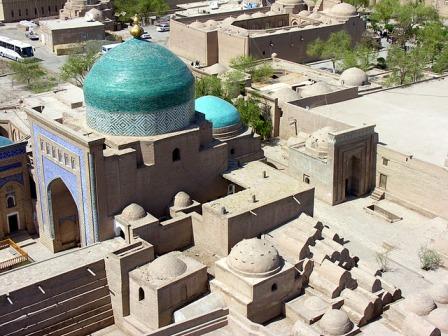 In 1810, after one of the most successful campaigns, Muhammad Rahim Khan I, decided to radically change the ensemble. He reconstructed the mausoleum of Pahlavan Mahmud, so that the "legs" of the saint of Khiva came necropolis of the ruling Kungrad dynasty. Here are buried members of the Khan family, and the area of the mausoleum has expanded to the east and south. The new mausoleum included the old vault and “khanaka” with high double dome, which silhouette was one of the main simbols of Khiva.
In 1810, after one of the most successful campaigns, Muhammad Rahim Khan I, decided to radically change the ensemble. He reconstructed the mausoleum of Pahlavan Mahmud, so that the "legs" of the saint of Khiva came necropolis of the ruling Kungrad dynasty. Here are buried members of the Khan family, and the area of the mausoleum has expanded to the east and south. The new mausoleum included the old vault and “khanaka” with high double dome, which silhouette was one of the main simbols of Khiva.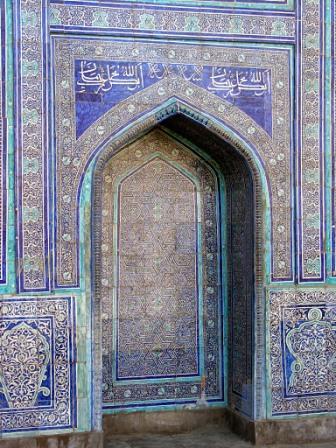 In majolica memorial included many religious sayings, poems of Pahlavan Mahmud and masters names. Headstone of Pahlavan Mahmud striking jeweler's precision and elegance of a mosaic of carved glazed ceramics.
In majolica memorial included many religious sayings, poems of Pahlavan Mahmud and masters names. Headstone of Pahlavan Mahmud striking jeweler's precision and elegance of a mosaic of carved glazed ceramics.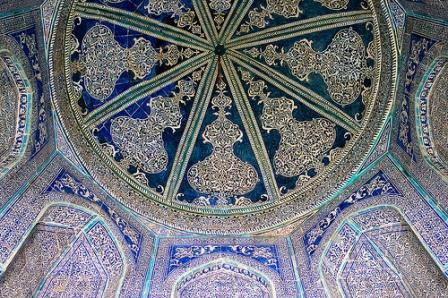 Especially Pahlavan Mahmud glorified his poems, in which the hero praised the courage, honesty, love for people. It is called the "Khorezmian Omar Khayyam". It is believed that he is the author of more than 300 “rubayi” - traditional oriental quatrains lovingly and philosophical content, which praised the Pahlavan Mahmud earthly life with all its sorrows and joys. The first Europeans who have established a direct link between the Pahlavan Mahmud and the author of “rubayi”, inscribed over the dome of the mausoleum, was a Hungarian Orientalist and traveler Arminius Vamberi, who visited Khiva in the second half of the XIX century, under the guise of a wandering dervish. Unfortunately, the poems of Pahlavan Mahmud, who wrote under the pseudonym Piryar-Wali, except those that were found on the walls of the tomb, did not survive.
Especially Pahlavan Mahmud glorified his poems, in which the hero praised the courage, honesty, love for people. It is called the "Khorezmian Omar Khayyam". It is believed that he is the author of more than 300 “rubayi” - traditional oriental quatrains lovingly and philosophical content, which praised the Pahlavan Mahmud earthly life with all its sorrows and joys. The first Europeans who have established a direct link between the Pahlavan Mahmud and the author of “rubayi”, inscribed over the dome of the mausoleum, was a Hungarian Orientalist and traveler Arminius Vamberi, who visited Khiva in the second half of the XIX century, under the guise of a wandering dervish. Unfortunately, the poems of Pahlavan Mahmud, who wrote under the pseudonym Piryar-Wali, except those that were found on the walls of the tomb, did not survive.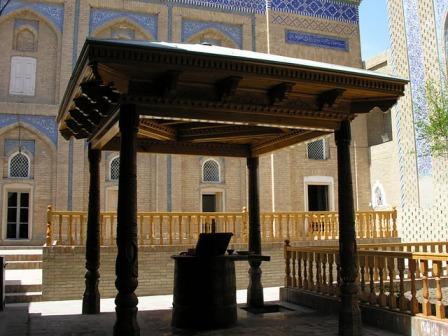 In his philosophical studies, Hercules developed the concept of morality, courage and valor. He was one of the pillars of the Sufi doctrine "Javonmardlik" ("Brave of the Youth"), the basic principles which - generosity, compassion, humility and obedience to the Creator.
In his philosophical studies, Hercules developed the concept of morality, courage and valor. He was one of the pillars of the Sufi doctrine "Javonmardlik" ("Brave of the Youth"), the basic principles which - generosity, compassion, humility and obedience to the Creator.














